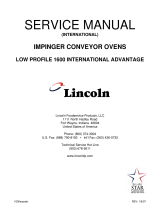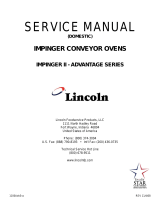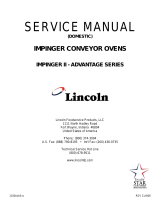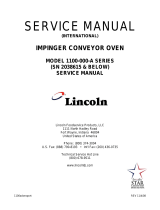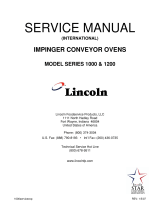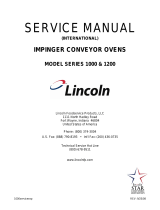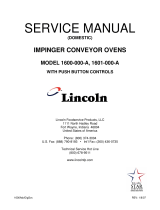Page is loading ...

SERVICE MANUAL
(INTERNATIONAL)
IMPINGER CONVEYOR OVENS
MODEL 1100 SERIES
1100exportsvc REV: 11/4/08
Lincoln Foodservice Products, Inc.
1111 North Hadley Road
Fort Wayne, Indiana USA 46804
United States of America
Phone: (800) 374-3004 • Fax: (260) 436-0735
Technical Service Hot Line
(800) 678-9511
www.lincolnfp.com

TABLE OF CONTENTS
SEQUENCE OFOPERATIONS 1104 THRU 1106...................................................... 3-4
SEQUENCE OF OPERATIONS 1134, 1135, 1136, 1150........................................... 5-6
SEQUENCE OF OPERATIONS 1151....................................................................... 7-8
SEQUENCE OF OPERATIONS 1152 THRU 1158.................................................... 9-11
SCHEMATIC 1104, 1105......................................................................................... 12
SCHEMATIC 1106 ................................................................................................. 13
SCHEMATIC 1134, 1135, 1150 S/N 2011383 & BELOW.......................................... 14
SCHEMATIC 1134, 1135, S/N 2011383 & ABOVE................................................... 15
SCHEMATIC 1150 S/N 2011373 & ABOVE.............................................................. 16
SCHEMATIC 1136, S/N 2011383 & ABOVE............................................................. 17
SCHEMATIC 1136, S/N 20211383 & ABOVE........................................................... 18
SCHEMATIC 1151, S/N 2011383 & BELOW............................................................ 19
SCHEMATIC 1151, S/N 2011373 & ABOVE............................................................ 20
SCHEMATIC 1152 THRU 1158, S/N 2011383 & BELOW......................................... 21
SCHEMATIC 1152 THRU 1158, S/N 2011383 & ABOVE.......................................... 22
SCHEMATIC 1152 & 1153 S/N 2011821 & ABOVE.................................................. 23
SCHEMATIC 1154 THRU 1158, S/N 2011821 & ABOVE.......................................... 24
TROUBLE SHOOTING GUIDE, GAS OVENS 1152 THRU 1158.............................. 25-33
TROUBLE SHOOTING GUIDE, ELECTRIC OVENS 1104, 1105, 1106..................... 34-36
TROUBLE SHOOTING GUIDE, ELECTRIC OVENS 1134, 1135, 1136, 1150........... 37-40
TROUBLE SHOOTING GUIDE, ELECTRIC OVEN 1151......................................... 41-46
REMOVAL, INSTALLATION, AND ADJUSTMENTS................................................. 47-69
GENERAL, PARTS BREAKDOWN.......................................................................... 70
GENERAL, PARTS BLOW UP................................................................................. 71
CONTROL COMPARTMENT FRONT, PARTS BREAKDOWN.................................. 72
CONTROL COMPARTMENT FRONT, BLOW UP..................................................... 73
CONTROL COMPARTMENT FRONT, 1152 THRU 1158 PARTS BREAKDOWN....... 74
CONTROL COMPARTMENT FRONT, 1152 THRU 1158 BLOW UP......................... 75
CONTROL COMPARTMENT REAR, S/N 2011383 & BELOW PARTS..................... 76
CONTROL COMPARTMENT REAR, S/N 2011383 & BELOW BLOW UP................. 77
CONTROL COMPARTMENT REAR, S/N 2011383 & ABOVE PARTS...................... 78
CONTROL COMPARTMENT REAR, S/N 2011383 & ABOVE BLOW UP................. 79
CONTROL COMPARTMENT REAR, 1152 THRU 1158, S/N 2011821 & BELOW
PARTS BREAKDOWN................................................................................ 80
CONTROL COMPARTMENT REAR, 1152 THRU 1158, S/N2011821 & BELOW
BLOW UP...................................................................................................... 81
CONTROL COMPARTMENT REAR, 1152 THRU 1158, S/N 2011821 & ABOVE
PARTS BREAKDOWN................................................................................. 82
CONTROL COMPARTMENT REAR, 1152 THRU 1158, S/N2011821 & ABOVE
BLOW UP...................................................................................................... 83
OVEN BACK ASSEMBLY PARTS BREAKDOWN.................................................... 84
OVEN BACK ASSEMBLY BLOW UP...................................................................... 85
GEARMOTOR ASSEMBLY PARTS BREAKDOWN................................................. 86
GEARMOTOR ASSEMBLY BLOW UP.................................................................... 87
CONVEYOR / DOOR PARTS BREAKDOWN......................................................... 88
CONVEYOR / DOOR BLOW UP.............................................................................. 89
Impinger II - 1100 Series Service Manual - International2

SEQUENCE OF OPERATIONS 1104 thru 1106
MODEL 1104 ELECTRIC 380/220 VAC 50 HZ 3 PHASE
MODEL 1105 ELECTRIC 415/240 VAC 50 HZ 3 PHASE
MODEL 1106 ELECTRIC 240 VAC 50 HZ 1 PHASE
POWER SUPPLY Electrical power to be supplied to the oven by a five conductor service on
Models 1104 and 1105 and a three conductor service on the 1106.
MAIN FAN CIRCUIT Power is permanently supplied (through a 10A fuse) to the normally open
contact of the main fan relay, the normally open cool-down thermostat and
to the normally open main fan switch. Closing the main fan switch supplies
line voltage to the primary of the power transformer (The transformer steps
the voltage down to 120 VAC for the control circuit). 120 VAC is supplied
to the coil of the main fan relay, its normally open contacts now close,
energizing the main fan motor. Closing the main fan switch also supplies
120 VAC to the cooling fan and, through a normally closed hi-limit thermo-
stat, the time/temp display, heat and conveyor switches.
HEATER CIRCUIT Closing the Heater Switch provides power through the normally open Air
Pressure Switch through the 3 Amp Fuse, to the Temperature Control
Board and to the Heater Lamp.
TEMPERATURE CONTROL Closing the Heat Switch supplies 120 VAC to the Electronic Temperature
Control. The 2.5K ohm Potentiometer is adjusted to achieve the desired
temperature. The Thermocouple will provide varying millivolts to the
Temperature Control. The temperature control board then supplies 120
VAC to the coil of the Contactor at intermittent intervals to maintain the
desired temperature.
NOTE: Units with Serial Number prior to 2000782 were equipped with a
Fenwall Temperature Control and used a Temperature Control Potentiom-
eter rated at 5K ohms.
CONVEYOR DRIVE Closing the Conveyor Switch supplies 120 VAC to the DC Motor Control
Board at terminals L1 and L2. A.C.volts are converted to DC volts and are
supplied to the Conveyor Motor at terminals A+ and A-. Adjustment of the
Speed Control Potentiometer (5,000 ohm, 10 turn) will change resistance
at terminals P1, P2, and P3 varying the DC voltage to the Conveyor Motor.
The speed of the conveyor motor will increase or decrease as the DC
voltage from the board increases or decreases respectively. As the motor
turns, it drives both the reducer gear box and the tach. generator. The
tach. generator is a DC voltage generator which supplies a voltage to the
DC Motor Control Board and is used as a reference for maintaining
a constant conveyor speed.
TIME/TEMP DISPLAY The secondary output of the Transformer, is supplied to terminals 1, 2,
and 3 of the Time/Temp. Display. The secondary output of the Transformer
is nominally 12. to 15 VAC with a center tap. The voltage from center
tap to each leg is 1/2 the secondary voltage
The speed side of the Time/Temp. Display uses a slotted disc (cemented
to tach. coupling) to break the infra-red light beam of the optical encoder
(mounted on gear motor) producing electrical pulses that are transmitted
to the display. The display converts these pulses into a read-out of min
The temperature portion of the Time/Temp Display uses a Thermistor
Impinger II - 1100 Series Service Manual - International 3

The temperature portion of the Time/Temp Display uses a Thermistor
Probe to sense oven temperature. The thermistor outputs a resistance
proportional to the oven temperature. This resistance is then converted by
the display into a temperature reading.
AUTOMATIC COOL DOWN When the oven reaches operating temperature the normally open Oven
Cool Down Thermostat closes. After the oven is switched OFF, the Ther
mostat bypasses the Fan Switch, keeping the Cooling Fan and Main Fan
in operation until the oven cools down to approximately 200°F (93.3°C).
Impinger II - 1100 Series Service Manual - International4

SEQUENCE OF OPERATION 1134 - 1135 - 1136 - 1150
MODEL 1134 ELECTRIC 220/380 VAC 50 HZ 3 PHASE
MODEL 1135 ELECTRIC 240/415 VAC 50 HZ 3 PHASE
MODEL 1136 ELECTRIC 240 VAC 50 HZ 1 PHASE
MODEL 1150 ELECTRIC 220/380 VAC 50 HZ 3 PHASE
POWER SUPPLY Electrical power to be supplied to the oven by a three conductor service on
single phase and a five conductor service on three phase.
CONTROL BOX AUTO When the temperature in the control box reaches
COOL DOWN 120°F ± 3°F (48.9°C ± 1.7°C), the Cooling Fan Thermostat closes,
switching power to the Cooling Fans. The thermostat will open at 100°F ±
3°F (37.8°C ± 1.7°C) interrupting power to the Cooling Fans.
MAIN FAN CIRCUIT Power is supplied by Line 1 on Model 1136 and L2 on 1134, 1135, and
1150 to the normally open main fan relay. Power is also supplied from Line
1, through the 1 Amp Fuse to the primary of the Step Down Transformer.
120 V AC is continuously supplied from Transformer secondary to terminal
number 1 of the 20 Minute Timer and through the High Limit Thermostat
(normally closed) to the Main Fan Switch. Closing the Fan Switch ener-
gizes the coil of the oven start relay, its contacts close enabling the 20
minute time delay module. The 20 minute time delay module supplies 120
VAC to the oven fan relay, this normally open contact now closes supply-
ing line voltage to the main fan motor. The cooling fans and the time/temp
display transformer are also energized.
HEATING CIRCUIT Closing the Heat Switch supplies 120 volts AC through the normally open
Air Pressure Switch (closed by air pressure from the Main Fan), the 3
Amp Fuse, to terminal L1 of the Temperature Control Board, and the Heat
Indicator Light.
TEMPERATURE CONTROL Closing the Heat Switch supplies 120 VAC to the Electronic Temperature
Control. The 2.5K ohm Potentiometer is adjusted to achieve the desired
temperature. The Thermocouple will provide varying millivolts to the
Temperature Control. The temperature control board then supplies 120
VAC to the coil of the Contactor at intermittent intervals to maintain the
desired temperature.
CONVEYOR DRIVE Closing the Conveyor Switch supplies 120 VAC to the DC Motor Control
Board at terminals L1 and L2. AC volts are converted to DC volts and are
supplied to the Conveyor Motor at terminals A+ and A-. Adjustment
S/N 2011383 and above of the Speed Control Potentiometer (5,000 ohm, 10 turn)
REFER TO PAGE B15 will change resistance at terminals P1, P2, and P3varying the DC voltage
to the Conveyor Motor. The speed of the conveyor motor will increase or
decrease as the DC voltage from the board increases or decreases
respectively. As the motor turns, it drives both the reducergear box and
the Tach. Generator. The tach. generatoris a DC voltage generator which
supplies a voltage to the DC Motor Control Board and is used as a
reference for maintaining a constant conveyor speed.
TIME/TEMP DISPLAY The secondary output of the Display Transformer, is supplied to terminals
1, 2, and 3 of the Time/Temp. Display.The secondary output of the Trans-
former is nominally 12.5 to 15 VAC with a center tap. The voltage from
center tap to each leg is 1/2 the secondary voltage.
The speed side of the Time/Temp. Display uses a slotted disc
Impinger II - 1100 Series Service Manual - International 5

S/N 2011383 and above (cemented to tach. coupling) to break the infra-red light beam
REFER TO PAGE B15 of the optical encoder(mounted on gear motor), producingelectri
cal pulses that are transmitted to the display. The display con
verts these pulses into a read-out of minutes and seconds.
The temperature portion of the Time/Temp Display uses a Ther
mistor Probe to sense oven temperature. The thermistor outputs
a resistance proportional to the oven temperature. This resis
tance is then converted by the display into a temperature reading.
AUTOMATIC COOL DOWN When this oven is started, the time delay relay timing circuit is
enabled, permitting the oven fans to run for approximately 20
minutes after the oven is shut off, to cool the oven. The Time
Delay Relay will keep the coil of Relay closed, maintaining opera
tion of the Main Fan Motor and the cooling fans
Impinger II - 1100 Series Service Manual - International6

SEQUENCE OF OPERATIONS - 1151
MODEL 1151 ELECTRIC 200 VAC 60 HZ 3 PHASE
POWER SUPPLY Electrical power to be supplied to the oven by a four conductor service.
CONTROL BOX AUTO When the temperature in the control box reaches
COOL DOWN 120°F ± 3°F (48.9°C ± 1.7°C), the Cooling Fan
Thermostat closes, switching power to the Cooling Fans. The thermostat
will open at 100°F ± 3°F(37.8°C ± 1.7°C) interrupting power to Cooling
Fans.
MAIN FAN CIRCUIT Power is permanently supplied through a 1A fuse to the primary of the
step-down transformer. The transformer steps the voltage down to 120
VAC for the control circuit. 120 VAC is supplied to terminal #1 of the 20
minute time delay relay, through the normally closed hi-limit thermostat, to
a normally open contact of the oven start relay, the cooling fan thermostat
and to the normally open main fan switch.
Closing the fan switch energizes the oven start relay. These normally open
contacts now close enabling the 20 minute timer delay. The 20 minute
time delay relay supplies 120 VAC to the coil of the oven fan relay, these
normally open contacts now close supplying 200 VAC to the main fan
motor. The cooling fans, time/temp display, conveyor switch and heat
switch are also energized.
HEATER CIRCUIT Closing the Heater Switch supplies 120 VAC through the normally open
Air Pressure Switch (which was closed by Main Fan Air Pressure), through
the 3 Amp Fuse, to the Temperature Control Board and to the Heater
Lamp.
TEMPERATURE CONTROL Closing the Heat Switch supplies 120 VAC to the Electronic Temperature
Control. The 2.5K ohm Potentiometer is adjusted to achieve the desired
temperature. The Thermocouple will provide varying millivolts to the
Temperature Control. The temperature control board then supplies 120
VAC to the coil of the Contactor at intermittent intervals to maintain the
desired temperature.
CONVEYOR DRIVE Closing the Conveyor Switch supplies 120 VAC to the DC Motor Control
Board at terminals L1 and L2. AC volts are converted to DC volts and are
supplied to the Conveyor Motor at terminals A+ and A-. Adjustment
S/N 2011383 and above of the Speed Control Potentiometer (5,000 ohm, 10 turn)
REFER TO PAGE B15 will change resistance at terminals P1, P2, and P3
varying the DC voltage to the Conveyor Motor. Thespeed of the conveyor
motor will increase or decrease as the DC voltage from the board in-
creases or decreases respectively. As the motor turns, it drives both the
reducergear box and the Tach. Generator. The tach. generatoris a DC
voltage generator which supplies a voltage to the DC Motor Control Board
and is used as a reference formaintaining a constant conveyor speed.
TIME/TEMP DISPLAY The secondary output of the Display Transformer, is supplied to terminals
1, 2, and 3 of the Time/Temp. Display. The secondary output of Trans-
former is nominally 12.5 to 15 VAC with a center tap. The voltage from
center tap to each leg is 1/2 the secondary voltage.
Impinger II - 1100 Series Service Manual - International 7

The speed side of the Time/Temp. Display uses a slotted disc
(cemented to tach. coupling) to break the infra-red light beam
2011383 and above of the optical encoder(mounted on gear motor),
Refer to Page B15 producing electrical pulses that are transmitted to the display. The display
converts these pulses into a read-out of minutes and seconds. The
temperature portion of the Time/Temp Display uses a Thermistor Probe to
sense oven temperature. The thermistor outputs a resistance proportional
to the oven temperature. This resistance is then converted by the display
into a temperature reading.
AUTOMATIC COOL DOWN When this oven is started, the time delay relay timing circuit is enabled,
permitting the oven fans to run for approximately 20 minutes after the oven
is shut off, to cool the oven. The Time Delay Relay will keep the coil of
Relay closed maintaining operation of the Main Fan Motor and cooling
fans.
Impinger II - 1100 Series Service Manual - International8

SEQUENCE OF OPERATIONS 1152 thru 1158
MODEL 1152 NAT.GAS 220 VAC 50 HZ 1 PHASE
MODEL 1153 L.P. GAS 220 VAC 50 HZ 1 PHASE
MODEL 1154 NAT. GAS 240 VAC 50 HZ 1 PHASE
MODEL 1155 L.P. GAS 240 VAC 50 HZ 1 PHASE
MODEL 1156 TOWN.GAS 220/240 VAC 50 HZ 1 PHASE
MODEL 1157 NAT. GAS 220/240 VAC 50 HZ 1 PHASE
MODEL 1158 L.P. GAS 220/240 VAC 50 HZ 1 PHASE
POWER SUPPLY Electrical power to be supplied to the oven by a three conductor service.
CONTROL BOX AUTO COOL DOWN When the temperature in the Control Box reaches
120°F ± 3°F (48.9°C ± 1.7°C), the Cooling Fan Thermostat will switch
power to the Control Box Cooling Fans. The Thermostat will interrupt
power to the Cooling Fans when ‘the control box temperature falls to
100°F ± 3°F (37.8°C ± 1.7°C).
MAIN FAN CIRCUIT Power is permanently supplied to the normally open contacts of the oven
fan relay, the normally open cooling fan thermostat, and to the normally
open oven fan switch. Closing the fan switch supplies line voltage,
through a 1A fuse, to the primary of the power transformer (the trans-
former steps the voltage down to 120 VAC for the control circuit.) 120
VAC is supplied to the cooling fans, terminal #1 of the time delay relay and
to the coil of the oven start relay. These normally open contacts close
enabling the 20 minute time delay relay. The 20 minute time delay relay
supplies 120 VAC to the oven fan relay, its normally open contacts now
close, supplying line voltage to the main fan motor.
BURNER CIRCUIT Closing the Fan Switch supplies line voltage through the 3 amp fuse, and
oven start relay (closed by activating the Relay in the main fan circuit).
Closing the Burner Switch allows voltage to be supplied through the
normally open gas pressure switch(located in gas valve and closed
when proper gas pressure is present), through the normally open Air
Pressure Switch (closed by air pressure from main fan), through the
normally closed oven cavity high limit thermostat (opens at 662°F (350°C)
which is manually resetting after a 18°F(10°C) drop), and to the ignition
control.
IGNITION CONTROL The Ignition Control switches (220 or 240 VAC) to the combustion Blower
Motor, the normally open combustion Air Switch closes upon sensing air
pressure in the burner housing. After a pre-purge period of between 30
and 60 seconds, the Spark Generator is energized, the Main Gas Valve
Solenoid Valve and Burner Pilot Light are energized, and ignition should
now occur.
When the burner ignition occurs, the Flame Sensor must provide micro
amps (normally
2-4 ) to the Ignition Control within 1 second or the burner
system will shut down and the buzzer alarm will sound. To recycle the
burner, switch off the burner switch (this will disable the buzzer), wait 30
seconds, push IN the reset button for the ignition control, and turn on the
Burner Switch. The burner sequence of events should now reoccur.
TEMPERATURE CONTROL Closing the Fan Switch supplies 120 VAC to the Electronic Temperature
Control. The 2.5K ohm Temperature Potentiometer is
Impinger II - 1100 Series Service Manual - International 9

adjusted to desired temperature. The Thermocouple will provide varying
millivolts to the Electronic Temperature Controller. The electronic tempera-
ture controller supplies 120 VAC to the Solenoid Valve at intermittent
intervals to maintain desired temperature.
CONVEYOR DRIVE Closing the Conveyor Switch supplies 120 VAC to the
D.C. Motor Control Board at terminals L1 and L2. AC volts are converted
to DC volts and are supplied to the Conveyor Motor at terminals A+ and A-
. Adjustment of the Speed Control
S/N 2011821 and above Potentiometer (5,000 ohm, 10 turn) will change resistance at Refer to
Page B15 terminals P1, P2, and P3 varying the DC voltage to the Conveyor Motor.
The speed of the conveyor motor will increase or decreaseas the
DC voltage from the board increases or decreases respectively. As the
motor turns, it drives both the reducer gear box and the Tach. Generator.
The tach. generator is a DC voltage generator which supplies a voltage to
the DC Motor Control Board and is used as a reference for maintaining a
constant conveyor speed.
TIME/TEMP DISPLAY The secondary output of the Display Transformer, is supplied to terminals
1, 2, and 3 of the Time/Temp. Display. The secondary output of Trans-
former is nominally 12.5 to 15 VAC with a center tap. The voltage from
center tap to each leg is 1/2 the secondary voltage.
S/N 2011821 and above
Refer to Page B15 The speed side of the Time/Temp. Display uses a slotted disc (cemented
to tach. coupling) to break the infra-red light beam of the optical encoder
(mounted on gear motor), producing electrical pulses that are transmitted
to the display. The display converts these pulses into a read-out of
minutes and seconds.
The temperature portion of the Time/Temp Display uses a Thermistor
Probe to sense oven temperature. The thermistor outputs a resistance
proportional to the oven temperature. This resistance is then converted by
the display into a temperature reading.
AUTOMATIC COOL DOWN When this oven is started, the time delay relay timing circuit is enabled,
permitting the oven fan to run for approximately 20 minutes after the oven
is shut off, to cool the oven. The Time Delay Relay will keep the coil of
Main Fan Relay closed, maintaining operation of the Main Fan Motor and
cooling fans.
CONVEYOR DRIVE Closing the Conveyor Switch supplies 120 VAC, through a 3 Amp Fuse,
to the primary of the Conveyor Control Transformer. The secondary of this
Transformer supplies 10 VAC and 29 VAC to the Conveyor Control. The
Conveyor Control supplies voltage pulses to the Conveyor Motor. The
Conveyor Control Potentiometer varies the frequency of these pulses. The
motor speed will increase or decrease, as the frequency of the pulses
increase or decrease respectively.
TIME/TEMP DISPLAY Closing the Main Fan Switch supplies 120 VAC to the primary
(STEPPER MOTOR DRIVE) of the Time/Temp Transformer. The secondary output of the Trans
former, 12.5 to 15 VAC with a center tap, is supplied to terminals 1, 2,
and 3 of the Time/Temp Display. The Display works on a balanced input,
and center tap voltage to each leg must be 1/2 the total reading.
The speed side of the Time/Temp Display is supplied by the Conveyor
Control, with the frequency of the pulses to the Conveyor Motor. This
frequency is converted by the Time/Temp Display into a read out of
minutes and seconds.
Impinger II - 1100 Series Service Manual - International10

NOTE: The Conveyor Control uses a sensor and magnet, mounted on the
Conveyor Motor that senses when the motor is not turning. If the motor is
not turning, the Time/Temp Display will show “—:— “ in the window.
The temperature portion of the display uses a Thermistor Probe to sense
oven temperature. The Thermistor outputs a resistance proportional to
oven temperature. This resistance is then converted by the Display into a
temperature reading.
OR:
The temperature potion of the display uses a “J” type thermocouple to
measure oven temperature. The thermocouple generates D.C. millivolts
proportional to oven temperature. This millivolt reading is then converted
by the display into a temperature reading.
Impinger II - 1100 Series Service Manual - International 11

SCHEMATIC 1104-1105
Impinger II - 1100 Series Service Manual - International12

SCHEMATIC 1106
Impinger II - 1100 Series Service Manual - International 13

SCHEMATIC 1134, 1135, 1150, S/N 2011383 AND BELOW
Impinger II - 1100 Series Service Manual - International
14

SCHEMATIC 1134, 1135 S/N 2011383 AND ABOVE
Impinger II - 1100 Series Service Manual - International
15

SCHEMATIC 1150 S/N 2011383 AND ABOVE
Impinger II - 1100 Series Service Manual - International
16

SCHEMATIC 1136, S/N 2011383 AND BELOW
Impinger II - 1100 Series Service Manual - International 17

SCHEMATIC 1136, S/N 2011383 AND ABOVE
Impinger II - 1100 Series Service Manual - International
18

SCHEMATIC 1151 S/N 2011383 AND BELOW
Impinger II - 1100 Series Service Manual - International
19

SCHEMATIC 1151 S/N 2011383 AND ABOVE
Impinger II - 1100 Series Service Manual - International
20
/
